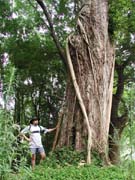
Mature tree in Kitchener Park, Feilding, New Zealand [Trevor Hinchliffe].

Mature tree, Glocester River [Trevor Hinchliffe].

Upper trunks of two large trees, Glocester River [Trevor Hinchliffe].

Foliage of tree in Wollongong [Trevor Hinchliffe].

Female strobili of tree in Wollongong [Trevor Hinchliffe].

Bark of tree in Paramatta, NSW [Trevor Hinchliffe].

Conservation Status

Podocarpus elatus
R. Br. ex Endlicher 1847
Common names
Illawarra plum; brown pine, plum pine (Harden 1990), Australian plum.
Taxonomic notes
See (Gray 1958, Thompson 1961, de Laubenfels 1985). Base name for Nageia elata (Endl.) F. Muell.
Description
"Medium to large tree with brown to dark brown bark that is often fissured and scaly on old trees. Leaves oblong to linear, 6-18 mm wide, 5-14 cm long, midvein prominent, other veins obscure. Male cones narrow-cylindrical, catkin-like, to 3 cm long, in ± sessile, axillary clusters. Female cones axillary, stalked, solitary; scales few, fleshy, uniting with the stalk to form a fleshy receptacle. Fruiting receptacle blue-black, glaucous, fleshy, to 20 mm diam., bearing an almost globose seed c 10 mm diam.; ripe Mar.-July" (Harden 1990). See García Esteban et al. (2004) for a detailed characterization of the wood anatomy.
Distribution and Ecology
Australia: New South Wales and Queensland, "in and around rainforest north from the
Beecroft Peninsula" (Harden 1990). You can create a highly detailed map, and access specimen data, using the "search" function at the Australia Virtual Herbarium.
Based on data from 87 collection localities, it grows at elevations of 160 ±190 m. Within its range, mean annual temperature is 18.3°C, with an average minimum in the coldest month of 7.4°C, and a mean annual precipitation of 1396 mm (Biffin et al. 2011, Table S5). Zone 10 (cold hardiness limit between -1°C and +4.4°C) (Bannister and Neuner 2001).
Remarkable Specimens
In 2010, an ornamental specimen in Parramatta, NSW was measured at 143 cm dbh and 17.0 m tall with an 18.0 m crown spread (National Register of Big Trees 2012).
Ethnobotany
Exploited for timber and sometimes planted as an ornamental, primarily in Australia (Harden 1990). The wood has a straight grain with inconspicuous growth rings, and is used for fine work including furniture, kitchen utensils, musical instruments (piano keys and violin bellies) and wood turning (ANBG 2009).
"The seed is borne on a purple-black fleshy stalk, which was eaten [by Aboriginals]. It is sweet but mucilaginous" (Fagg 1992).
Observations
Remarks
Galbraith et al. (1973) isolated a steroid called Podecdysone C from the bark of P. elatus, and also found it in several other species of Podocarpus . This compound has a structure extremely similar to that of hormones that induce moulting in insects, which prompts the obvious question, what does that achieve for P. elatus? Is it an insecticide? However, no one seems to have followed up on this question.
Citations
Australian National Botanic Gardens [ANBG]. 2009. Podocarpus elatus. http://www.anbg.gov.au/anbg/conifers/podocarpus-elatus.html, accessed 2009.12.09, now defunct.
Endlicher, Stephano. 1847. Synopsis Coniferarum, p. 213. Available: Biodiversity Heritage Library, accessed 2023.01.07.
Galbraith, M. N. Galbraith, D. H. S. Horn, E. J. Middleton, J. N. Kaplanis, and M. J. Thompson. 1973. Structure of podecdysone C, a steroid with moulting hormone activity from the bark of Podocarpus elatus R. Br. Cellular and Molecular Life Sciences 29(7):782.
National Register of Big Trees. 2012. Tree Register: National Registry of Big Trees. www.nationalregisterofbigtrees.com.au, accessed 2012.06.23.
See also
Gray, Netta E. 1958. A Taxonomic Revision of Podocarpus, XI. The South Pacific Species of Section Podocarpus, Subsection B. Journal of the Arnold Arboretum 39:474. Available: Biodiversity Heritage Library, accessed 2023.01.08.






